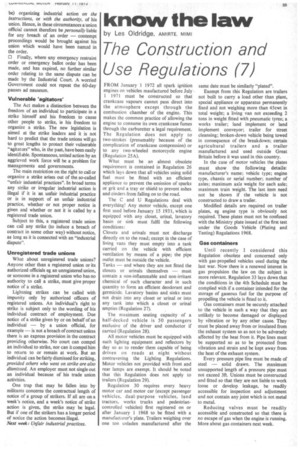know the law
Page 61

If you've noticed an error in this article please click here to report it so we can fix it.
by Les Oldridge, AMIRTE, MIMI
The Construction and Use Regulations (7)
FROM January 1 1972 all spark ignition engines on vehicles maufactured before July 1 1971 must be constructed so that crankcase vapours cannot pass direct into the atmosphere except through the combustion chamber of the engine. This makes the common practice of allowing the engine to consume its own crankcase fumes through the carburetter a legal requirement. The Regulation does not apply to two-strokes (presumably because of the complication of crankcase compression) or to any two-wheeled motorcycle engine (Regulation 25A).
What must be an almost obsolete requirement is contained in Regulation 26 which lays down that all vehicles using solid fuel must be fitted with an efficient appliance to prevent the emission of sparks or grit and a tray or shield to prevent ashes and cinders from falling on to the road.
The C and U Regulations deal with everything! Any motor vehicle, except one first used before January 15 1931, which is equipped with any closet, urinal, lavatory basin or sink must fulfil the following conditions: Closets and urinals must not discharge directly on to the road; except in the case of living vans they must empty into a tank carried on the vehicle with efficient ventilation by means of a pipe; the pipe outlet must be outside the vehicle.
Tanks — and where they are not fitted the closets or urinals themselves — must contain a non-inflammable and non-irritant chemical of such character and in such quantity to form an efficient deodorant and germicide. Lavatory basins and sinks must not drain into any closet or urinal or into any tank into which a closet or urinal empties (Regulation 27).
The maximum seating capacity of a half-decked vehicle is 50 passengers exclusive of the driver and conductor if carried (Regulation 28).
All motor vehicles must be equipped with such lighting equipment and reflectors by day so as to render them capable of being driven on roads at night without contravening the Lighting Regulations. Motor vehicles not provided with front and rear lamps are exempt. It should be noted that this Regulation does not apply to trailers (Regulation 29).
Regulation 30 requires every heavy motor car and motor car (except passenger vehicles, dual-purpose vehicles, land tractors, works trucks and pedestriancontrolled vehicles) first registered on or after January I 1968 to be fitted with a manufacturer's plate. Trailers weighing over one ton unladen manufactured after the same date must be similarly "plated".
Exempt from this Regulation are trailers not built to carry a load other than plant, special appliance or apparatus permanently fixed and not weighing more than 45cwt in total weight; a living van not exceeding 2 tons in weight fitted with pneumatic tyres; a works trailer; land implement or land implement conveyor; trailer for street cleansing; broken-down vehicle being towed in consequence of the breakdown; certain agricultural trailers and a trailer manufactured and used outside Great Britain before it was used in this country.
In the case of motor vehicles the plates must show the following details: manufacturer's name; vehicle type; engine type, chassis or serial number; number of axles; maximum axle weight for each axle; maximum train weight. The last item need not be shown if the vehicle is not constructed to draw a trailer.
Modified details are required on trailer plates, eg engine type is obviously not required. These plates must not be confused with the Ministry plate issued at the first test under the Goods Vehicle (Plating and Testing) Regulations 1968.
Gas containers Until recently I considered this Regulation obsolete and concerned only with gas-propelled vehicles used during the last war. Now there is a renewed interest in gas propulsion the law on the subject is more relevant. Regulation 33 lays down that the conditions in the 4th Schedule must be complied with if a container intended for the storage of gaseous fuel for the purpose of propelling the vehicle is fitted to it.
Gas containers must be securely attached to the vehicle in such a way that they are unlikely to become damaged or displayed by vibration or by any other cause. They must be placed away from or insulated from the exhaust system so as not to be adversely affected by the heat from it. Pipe lines must be supported so as to be protected from vibration and strain and be kept away from the heat of the exhaust system.
Every pressure pipe line must be made of steel -solid drawn. The maximum unsupported length of a pressure pipe must not exceed 311. Unions must be constructed and fitted so that they are not liable to work loose or develop leakage, be readily accessible for inspection and adjustment and not contain any joint which is not metal to metal.
Reducing valves must be readily accessible and constructed so that there is no escape of gas when the engine is running. More about gas containers next week.








































































































